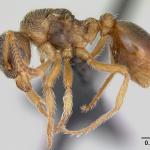Myrmica karavajevi is a very rare, workerless parasite of Myrmica colonies. Queens and males are produced in large numbers and can be recognised by their very small size: they are slightly smaller than the host workers. It was known as Sifolinia karavajevi until Bolton (1988) synonymised Sifolinia with Myrmica. Seifert calls this species Symbiomyma karavajwevi in his 2018 book however this change of name has yet to be generally accepted. The females have simple, smoothly curving scapes and short spines and could possibly be mistaken for very small Myrmica rubra females. The forward facing process beneath the postpetiole is a clear distinguishing characteristic.
Dorset, North and South Hampshire, Surrey, Pembrokeshire, West Suffolk and West Norfolk.
North-west, central, eastern and northern Europe to 63° North (Seifert 2007).
Listed as Rare (RDB3) by Shirt (1987) and revised to Insufficiently Known (RBDK) by Falk (1991).
It has been found where its host nests are plentiful. Usually in warm and relatively wet places such as bogs, marshes, damp heaths, meadows and forest clearings, less frequently in sandy or dry places.
July or August.
A new queen enters a nest of the host and, after acceptance, lives alongside the host queen(s). Workers and possibly alates of the host species continue to be produced as well as many small alates of the parasite. In Britain it has been found in nests of Myrmica scabrinodis Nylander and M. sabuleti Meinert.
It does not forage, but relies on host workers for food.
2022


